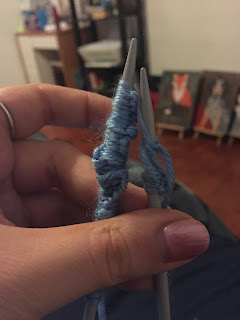THE
PROJECT.
The goal of this project was to use
YouTube, social networking, and online help forums to learn how to knit. Given
time constraints, I did not intend to knit a specific item; rather, I sought to
successfully cast on and complete as many rows of stitches as I could. The main
resources I used were WikiHow articles and YouTube videos. I would have liked
to have incorporated Twitter as a means of getting feedback and commentary on
my progress, however internet problems prevented it. Ultimately, I had trouble
learning how to perform the knit stitch and was unable to complete more than
two rows of stitches before knotting the yarn and needing to restart.
THE ADVANTAGES.
One strength of this learning method,
perhaps obviously, was accessibility. The internet connects us to a large
catalogue of resources, including articles, videos, and even living experts.
Because of this, when encountering a problem, I could search out alternative
instructions given by different teachers using different techniques and
explanations. I found that these variations both facilitated my understanding
and allowed me to find methods that worked for me personally. Additionally, as
noted by Professor Hagerman in our second module, "evidence suggests that
when learners access ideas or information via multiple modes, they tend to
learn more (e.g., Gellevij, Van der Meij, DeJong & Pieters, 2002; Paivio,
1986)" (Hagerman, 2018). It follows in this vein, therefore, that this
method of learning, which allows students to search out instruction presented in
a variety of multimodal formats, would have a powerful resonance on learning.
THE DISADVANTAGES.
One disadvantage I found was that
while it was easy enough to find resources detailing how to knit in a variety
of different ways, it proved difficult to identify errors I was making and find
solutions. Lacking any familiarity with knitting or similar skills, I did not
have any prior knowledge to draw on to self-correct or adapt for myself. As
Professor Hagerman cited in our first module, open education is a means of
equalizing access to education by facilitating access to the necessary tools
and resources (Hagerman, 2018). However, "not only have the advantages of
learning in [properly executed] small groups been well documented…but effective
group practices have also been identified” (Gillespie et al., 2006, p.81).
Additionally, further research has supported that “instructor immediacy [i.e.,
teaching presence] was more predictive of effective and cognitive learning”
(Garrison, 2007, p.69) than peer-interaction alone. Combined, these two
observations would support that this method of learning would be more
beneficial in combination with teacher led instruction and/or small group
learning.
THE COMPLEXITIES.
Papert and Harel in discussing
constructionism note how engagement in construction can promote a variety of
connected learning, such as in their example of cybernetic LEGO sets serving as
a vehicle for mathematical learning (p.7). In working on this project, for
instance, I feel that I was also able to strengthen my research skills as I
sought videos and forums that provided applicable information that I could use
in my knitting attempts. That, I feel, was one of the more notable complexities
of this project; how the learning transcended the initial parameters to spread
out and incorporate skills and knowledge beyond the expected, embracing the
diversity of learning experiences Papert and Harel speak of in their article
(p.8). On a whole, despite my struggle and ultimate inability to successfully
learn to knit, this project serves as a first impact experience, opening a
doorway towards deeper learning practices. In this regard, open education holds
merit, in my opinion, as a means of deepening and expanding an existing knowledge
base.
RESOURCES.
Garrison, D. R.
(2007). Online community of inquiry review: Social, cognitive, and teaching
presence issues. Journal of Asynchronous
Learning Networks, 11(1), 61-72.
Gillespie, D.,
Rosamond, S., Thomas, E. (2006). Grouped Out? Undergraduates' Default
Strategies For Participating In Multiple Small Groups. The Journal of General Education, 55(2), 81-102.
Hagerman, M.S.
(2018). EDU5188[WB] Integration of
Technology in Education, module 1 lecture [Online post]. Retrieved from
https://uottawa.brightspace.com/d2l/le/content/77425/viewContent/1775741/View
Hagerman, M.S.
(2018). EDU5188[WB] Integration of
Technology in Education, module 2 lecture [Online post]. Retrieved from
https://uottawa.brightspace.com/d2l/le/content/77425/viewContent/1787346/View
Papert, S. &
Harel, I. (1991). Situating Constructionism. Constructionism, 1–11. http://doi.org/10.1111/1467-9752.00269
LEARNING RESOURCES.
https://www.youtube.com/watch?v=nWJQvsZ6kT0
https://www.youtube.com/watch?v=hM5M2Fu0RtY
https://www.youtube.com/watch?v=ONVQCK_-rKc
https://www.wikihow.com/Knit
https://www.wikihow.com/Knit-the-Purl-Stitch
https://www.youtube.com/watch?v=9bufF8e24JY
https://www.youtube.com/watch?v=Zhrl7cQvwjc
LEARNING RESOURCES.
https://www.youtube.com/watch?v=nWJQvsZ6kT0
https://www.youtube.com/watch?v=hM5M2Fu0RtY
https://www.youtube.com/watch?v=ONVQCK_-rKc
https://www.wikihow.com/Knit
https://www.wikihow.com/Knit-the-Purl-Stitch
https://www.youtube.com/watch?v=9bufF8e24JY
https://www.youtube.com/watch?v=Zhrl7cQvwjc







